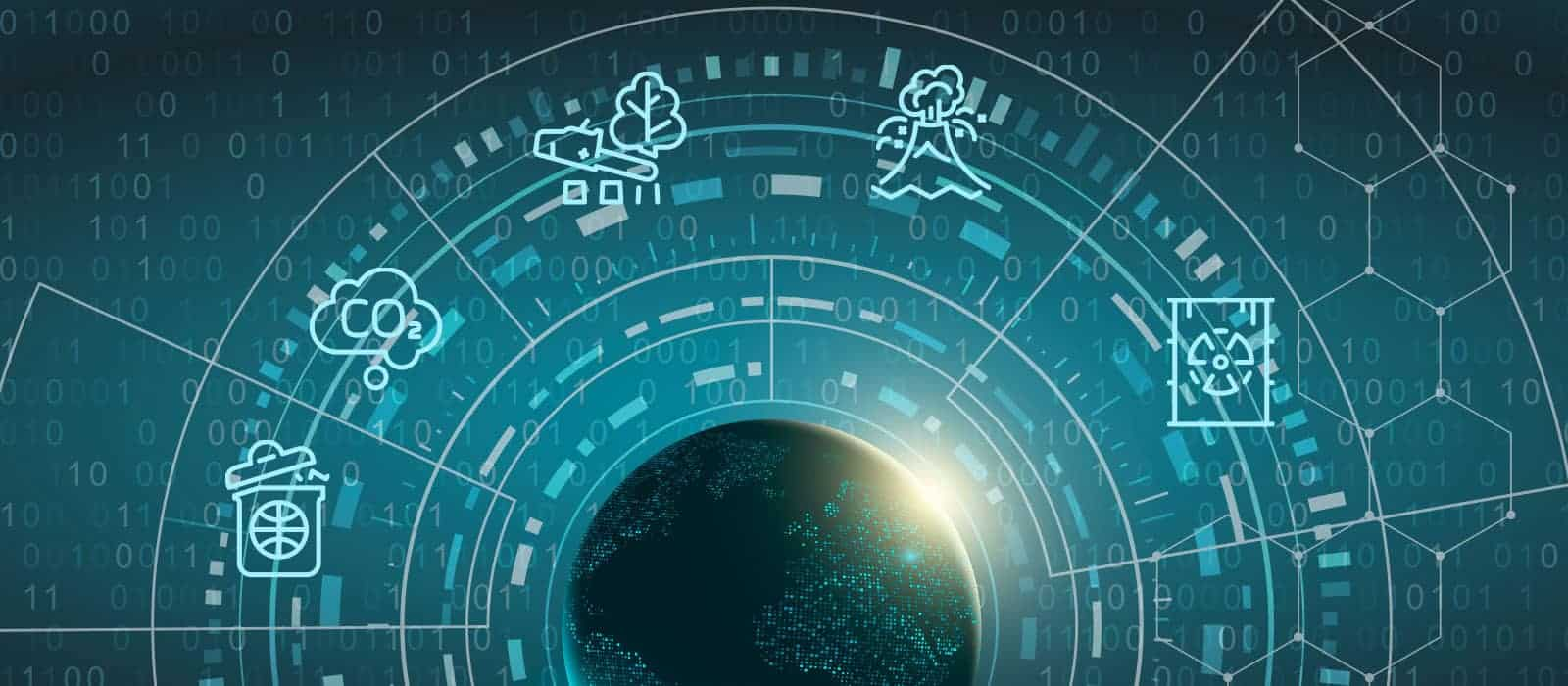Though best known for its applications in cryptocurrency, blockchains are finding diverse applications in various fields. Blockchain climate change application can further the cause of sustainability in the coming years.
Global warming is without a doubt a defining issue faced by humankind. The effects of anthropogenic climate change are likely to affect the life and livelihood of large fractions of the human race. This has prompted the scientific community across the globe to work towards mitigation measures. Interdisciplinary approaches have often found applications in this field, and blockchain technology is no exception.
The ability of blockchains to build robust ledgers that are both transparent and secure has been utilized primarily in the field of finance, specifically in cryptocurrency applications. Blockchain global warming initiatives formed to oversee climate change mitigation efforts, however, are also becoming a trend. Read on to find out more about these applications.
Blockchain Enforcing Climate Change Policies
It has been suggested that blockchain technology can find uses in climate policy enforcement. Blockchains offer a transparent method for ensuring regulatory compliance without the need for third-party assistance even when the process involved may be taking place across jurisdictions. The technology can be applied in any interaction where it is possible to create and trade in tokens.
This can, for example, find applications in the global supply chain where green measures can be accounted for and maintained using a decentralized ledger without involving any centralized control. However, it should be noted that only select policy measures can be codified in tokens.
Some researchers do argue that blockchain-based approaches may be more energy-intensive and slower than traditional centralized databases. However, in many cases, the pros of using a blockchain such as transparency and reliability outweigh the penalty incurred in terms of resources and speed.
Building More Sustainable Finance with Blockchain
Globally, almost 80% of commercial activities require access to liquidity from financial institutions. However, the rigid centralized nature of traditional institutions often makes access to liquidity difficult, especially to those who are underprivileged. In addition, ineffective information transfer also makes the process tedious.
Applying blockchain technology can make compliance more transparent, and information flow more effective, thus making access to liquidity more equitable. As widening inequality is a key consequence of climate change, a more equitable financial system can go a long way in mitigating the harmful effects of economic inequality.
Blockchain Making Agriculture Smarter
Blockchain agriculture solutions can be used to connect farmers directly with retailers as well as for providing farmers with up to date information about weather and climate conditions, seed quality, market rates, etc. For example, the Flux Protocol, which is the largest co-op for environmental data, allows for the utilization of this information for agriculture using data mining, decentralized structure, and artificial intelligence.
Among other things, this will allow farmers to better adapt to the effects of climate change. It can also reduce agriculture loss due to irregular weather patterns and loss of agriculture products due to a lack of access to markets. This in turn leads to the conservation of resources such as water that goes into agricultural production, thereby further aiding in climate change and blockchain mitigation.
A major player in the area is IBM Food Trust which uses blockchains to provide all players in the farm to table ecosystem with up to date information to ensure reliable, transparent, and sustainable food systems. The application of blockchain in agriculture and agri-food supply is only expected to grow in the coming years.
![]()
Blockchain technology can also make the agri-food industry more reliable and safer by allowing for a traceable system that lets all players have access to all stages of the processes involved ranging from cultivation to processing and logistics. This can help ensure that green practices are followed throughout the agri-food supply chain, making the entire chain more sustainable.
In both the agriculture and agri-food industry, the primary challenge to implementing a blockchain-based solution would be providing access and training to the primary users (farmers) in effectively adopting this technology. Blockchain-based e-Learning software can be deployed to the network to ensure universal access and streamlined learning processes across individual distributed systems.
An interesting example of agriculture blockchain solutions is AgriLedger which provides a kind of market place for farmers and customers using blockchain technology. The system provides information and traceability to products, allows for financial transactions, and authenticates the process through digital identity verification. In essence, farmers and consumers who would otherwise not have interacted can now do so through a secure, transparent blockchain.
Emission Trading Secured Using Decentralized Systems
Emission Trading sees blockchain applied with the greatest ease. Much like in financial trading, blockchains can help record and transfer data related to carbon trading in a decentralized manner while ensuring security and reliability. This will allow for easier trading of carbon credits, especially when the trade spans multiple nationalities and jurisdictions.
The only downside is that countries across the globe have to agree on a common storage system. In addition, it is essential to verify the authenticity of carbon credits incurred as no physical measures taken can be verified using the blockchain. This can be achieved by introducing blockchain usage to agencies verifying carbon emission and reduction measures on the ground.
Blockchain Disaster Recovery Management
![]()
Disaster relief blockchain solutions can effectively provide a single management system containing all aspects of logistics operation that can be updated in real-time. This is of unique importance for managing supply chains during natural disasters. Mitigating natural disasters effectively is a key adaptation needed for building resilience to climate change. Therefore, utilizing blockchains in this area is of great importance.
The ongoing COVID-19 crisis drives increased application of blockchain-based solutions in disaster management. MYNXG, a leading German industrial IoT provider, uses blockchain technology for mobile phone tracking (contact tracing) without compromising privacy. Similar applications of blockchain disaster relief have been gaining traction in other parts of Europe as well.
Blockchain Development to Support Financial Inclusion
The role of blockchains in inclusive financial access has already been contemplated. Similarly, the transparent and decentralized nature of blockchain applications makes them ideal for preventing fraud, fund leakage, and other financial anomalies in development projects such as infrastructure building. In addition to promoting more equitable development, such an approach can also aid in building resilient infrastructure that can better withstand the effects of climate change.
Optimization of Energy Usage in Decentralized Systems
The application of blockchains in the energy market is projected to grow by 45% within the next 5 years. As decentralized renewable energy generation increases, so does the need for proper energy resource management systems to be put in place to allow balancing storage, generation, consumption, and sales of energy. A blockchain can be an effective way to maintain real-time information in this regard, allowing for the most efficient use of renewable energy.
Multiple applications of blockchains in the energy sector have already been identified. For example, the EW-DOS operating system uses a blockchain-based decentralized approach for facilitating low carbon energy distributed generation systems.
![]()
Tesla Energy Software is another good example here. The platform uses blockchains in conjecture with machine learning to optimize many processes, including utility bill minimization, smart grid control, and battery life management. These applications include the Autobidder, Opticaster, and Microgrid Controller software.
The characteristics of blockchain can go a long way in reducing wasted renewable generation, thereby decreasing the need for fossil fuel-based resources. In fact, in addition to renewables and smart grids, some of the largest players in the energy-blockchain arena are oil and gas companies.
Using blockchain technology for optimization of freight transport could reduce idling, overpayment, and discrepancies associated with third-party payments. According to Accenture, the integration brings a 5% costs reduction, which for an oil and gas sector company with annual revenue of $10 billion amounts to savings of $30 million.
Blockchain Solutions to Combat Deforestation
![]()
Deforestation accounts for 15% of global greenhouse emissions and any contribution in this area is of critical significance. The United Nation’s REDD program (Reducing Emissions from Deforestation and forest Degradation) or UN-REDD aims to enforce payments for the emissions generated by deforestation and then use these funds to provide sustainable forest conservation-related activities. However, this involves tracing the emissions through multiple processes and enterprises before it reaches the end-user.
Blockchains could be an ideal solution here, where a specific carbon cost is associated with each product purchase, and the decentralized ledger can then aggregate and translate these credits back. In theory, this is an idea of maintaining a chain of custody, although a practical implementation is yet to be achieved.
Blockchain-Based Waste Management Systems
![]()
Blockchains are an ideal solution for supply chain management. Secure, transparent, decentralized ledgers streamline communication and make highly reliable logistics systems. This aspect of blockchains has been exploited in waste management as well. Practical applications of blockchain for waste tracking do exist and are successful at least as pilot projects.
AgroTEch labs in the Netherlands works with the Rotterdam municipality to facilitate tamper-proof, blockchain-based transactions for waste management. Credit obtained by citizens that participate in the waste management project can be exchanged for services from local agencies much like regular money.
Another similar example is the Swachcoin which again converts credit from waste management and such green initiatives to facilitate local trade. IBMs Plastic Bank uses a similar concept to allow people to monetize ocean plastic. Members of the chain can collect plastic and supply the designated recycling centers in exchange for blockchain tokens that can be exchanged for goods.
The Dutch Ministry of Infrastructure uses blockchains to monitor the transport of waste in an accurate and transparent manner. On similar lines, AREP in France tracks the movement of every bin, along with information such as the amount of waste, details of personnel/companies handling the waste, etc. Taiwan employs blockchains and IoT technology to track every aspect of waste management from dustbins to landfills.
Effective waste management, especially with regards to waste items such as plastic and e-waste is a critical part of sustainable development. In addition, optimizing waste transport blockchain integration can reduce emissions associated with transportation, thereby further contributing to sustainability.
Green Buildings and Blockchain Management
![]()
Buildings and embodied energy of building materials account for a large fraction of carbon emissions. Blockchains can help mitigate these in different ways. For example, by using a blockchain-based system to control air quality, temperature, and other environmental factors in large buildings. This could lead to more precise data transmission and more accurate control is possible, leading to a lower overall energy footprint. This is where blockchain development services for the sustainability industry come in, offering innovative solutions to track and optimize energy consumption in buildings.
More applications of blockchains in construction involve the management of prefab constructions which pose a significant logistics challenge. Since prefab buildings are often easier to maintain and require less environmental controls (given that appropriate materials can be used), simplifying the logistics involved can reduce the emissions involved in construction. Mobile development for the sustainability industry can further enhance these solutions by providing real-time data and control over prefab construction processes, improving efficiency and reducing waste.
In addition, larger buildings or a collection of smaller green buildings can effectively share renewable energy grids using blockchain for efficient energy management. More accurate management of the demand and supply variations facilitated by the blockchain ledger will maximize the utilization of renewables, thus reducing fossil fuel dependence and emissions.
Conclusion
The key characteristics of a blockchain are transparency, decentralized data storage, reliability, and security. All these factors make blockchain technology versatile enough to handle diverse applications that can help mitigate or manage climate change. With evolving enterprise blockchain development, large scale applications of blockchains in this area will happen soon.
This is not to suggest that employing blockchain technology is without challenges. In many applications such as emission trading and public infrastructure building, it is essential that physical verification of the measures and steps involved is carried out.
Transferring such moves to a purely digital forum can result in large scale corruption if the agencies issuing the certificates involved are corrupt. Therefore, some countermeasures such as the involvement of multiple independent certifying agencies should be implemented.
While there is some energy penalty associated with decentralized processing, with the increased use of renewables by large technology companies, it is likely that this adverse effect will be largely mitigated.




